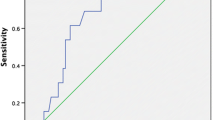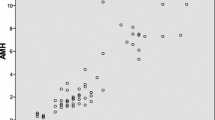Abstract
Materials and methods.
This retrospective study was carried out in order to assess the value of inhibin B as a predictive factor for the assisted reproduction-outcome. Inhibin B on the day of HCG-administration (ovulation induction) was measured in 15 pregnant and 16 non-pregnant patients (defined as positive serum-HCG) and compared by single and multiple logistic regression analysis with classical predictive factors such as estrogen and oocyte number. Both groups were similar with respect to age and cause of infertility.
Results.
While estrogen, FSH and LH at the HCG-day did not differ, inhibin B, the number of cumulus oocyte complexes and metaphase II -oocytes were statistically significantly different. In a single variable logistic model inhibin B, cumulus oocyte complexes and metaphase II oocytes showed significant correlation with pregnancy. When reassessed in a multiple variable logistic model only inhibin B maintained a considerable influence. Further inspection revealed, that the predictive inhibin B value at HCG-day <1200 pg/ml for failure of ART (assisted reproduction techniques) was 91%. Inhibin >1200 pg/ml showed 70% predictivity for pregnancy.
Conclusion.
In comparison to classical parameters inhibin B at HCG-day seems to be the better prognostic factor for the outcome of ART. Inhibin B <1200 pg/ml seems to be highly predictive for failure of ART.
Similar content being viewed by others
References
Albano C, Felberbaum RE, Smitz J, Riethmüller-Winzen H, Diedrich K, Devroey P (2000) Ovarian stimulation with HMG: results of a prospective randomised phase III European study comparing the luteinizing-releasing hormone (LHRH)-antagonist cetrorelix and the LHRH-agonist buserelin. Hum Reprod 15:526–531
Creus M, Penarrubia J, Fábregues F (2000) Day 3 serum inhibin B and FSH and age as predictors of assisted reproduction treatment outcome. Hum Reprod 11:2341–2346
Diedrich K, Diedrich C, Santos E, Zoll C, Al-Hasani S, Reissmann T, Krebs D (1994) Suppression of the endogenous luteinizing hormone surge by the gonadotrophin-releasing hormone antagonist Cetrorelix during ovarian stimulation. Hum Reprod 9:788–791
Eldar-Geva T, Robertson MD, Cahir N, Groome N, Gabbe MP, MacLachlan V, Healy DL (2000) Relationship between serum inhibin A and B and ovarian follicle development after a daily fixed dose administration of recombinant follicle-stimulating hormone. J Endocrinol Metab 85:607–613
Engel JB, Felberbaum R, Reissmann T, Kose R, Diedrich K (2001) Inhibin A/B in HMG or recombinant FSH ovarian stimulation with cetrorelix medication. Reprod Biomed 3:104–108
Groome NP, Illingworth PJ, Cooke I, Ganesan TS, Baird DT, McNeilly AS (1994) Detection of dimeric inhibin throughout the human menstrual cycle by 2-site enzyme immunoassay. Clin Endocrinol 6:717–723
Groome NP, Illingworth PJ, O'Brien M, Pai R, Rodger FE, Marther JP, McNeilly AS (1996) Measurement of dimeric inhibin-B throughout the human menstrual cycle. J Clin Endocrinol Metab 81:1401–1405
Hall JE, Welt CK, Cramer DW (1999) Inhibin A and B reflect ovarian function in assisted reproduction but are less useful at predicting outcome. Hum Reprod 14:409–415
Lockwood GM, Muttukrishna S, Groome NP, Ledger WL (1996) Circulating inhibins and activin A during GnRH-analogue down-regulation and ovarian hyperstimulation with recombinant FSH for in-vitro fertilisation-embryo transfer. Clin Endocrinol 45:741–748
Lockwood GM, Muttukrishna S, Ledger WL (1998) Inhibins and activins in human ovulation conception and pregnancy. Hum Reprod Update 4:284–295
Ludwig M, Felberbaum RE, Diedrich K, Hamm W, Riethmüller-Winzen H, Ulrich H (2000) Cetrorelix (Cetrotide®) im Mehrfachgabe. Protokoll zur ovariellen Stimulation bei der IVF. Reproduktionsmedizin 16:390–399
Muttukrishna S, Fowler PA, Groome NP, Mitchell GG, Robertson WR, Knight PG (1994) Serum concentration of dimeric inhibin during the spontaneous human menstrual cycle and after treatment with exogenous gonadotrophin. Hum Reprod 9:1634–1642
Penarrubia J, Balasch J, Fábregues F, Carmna F, Casamitjana R, Moreno V, Calafell J, Vanrell JA (2000) Day 5 inhibin B serum concentrations as predictors of assisted reproductive technology outcome in cycles stimulated with gonadotrophin-releasing hormone agonist gonadotrophin treatment. Hum Reprod 7:1499–1502
Seifer DB, Lambert-Messerlian G, Hogan JW, Gardiner AC, Blazar AS, Berk CA (1997) Day 3 serum inhibin B is predictive of assisted reproductive technologies outcome. Fertil Steril 67:11–15
Author information
Authors and Affiliations
Corresponding author
Rights and permissions
About this article
Cite this article
Engel, J.B., Felberbaum, R.E., Junge, K. et al. Inhibin B on the day of HCG-administration is a predictive factor for failure in assisted reproduction cycles. Arch Gynecol Obstet 268, 278–280 (2003). https://doi.org/10.1007/s00404-002-0442-0
Received:
Accepted:
Published:
Issue Date:
DOI: https://doi.org/10.1007/s00404-002-0442-0




